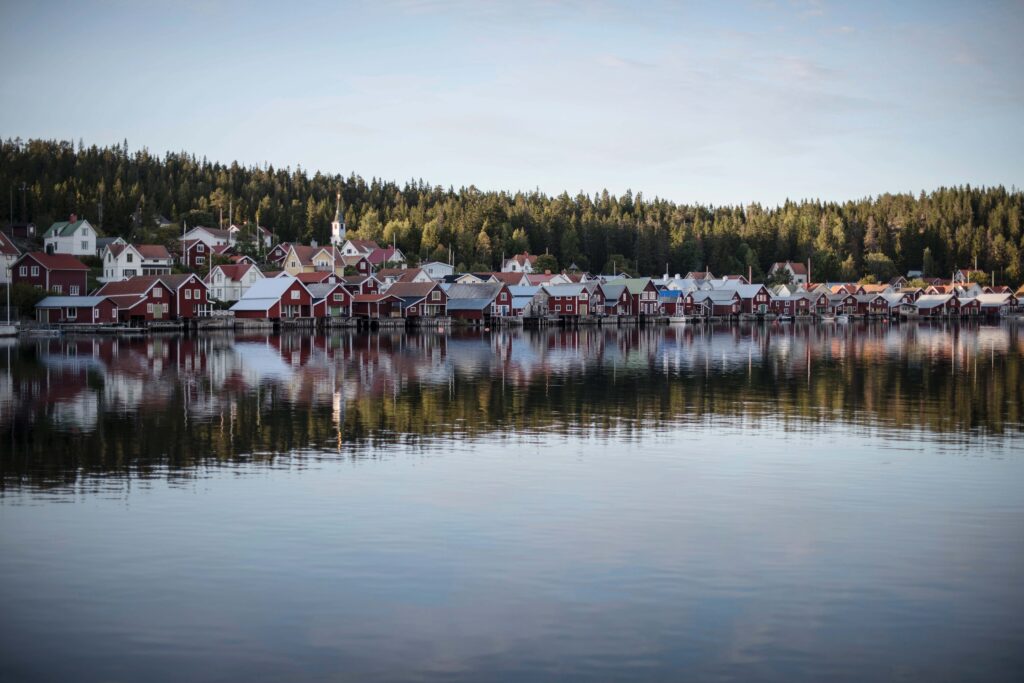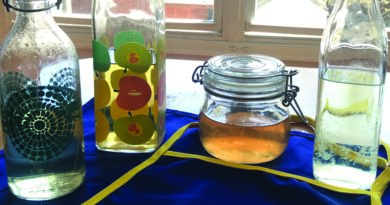Ulvön – The Mecca of Fermented Herring (and Reluctant Tourist Paradise)
Ulvön island is the gem of the High Coast archipelago. It is also known as the birthplace of Sweden’s infamously stinky fermented herring surströmming. Still produced on the island, Ulvön remains the best place to sample this smelly delicacy.

Dotted with rustic cottages, fishing huts, and boathouses, Ulvön is the largest island in the High Coast archipelago and, with 40 inhabitants, the most populous. The herring and salmon fishing have attracted fishermen here since the 1500s. Once home to northern Sweden’s largest fishing community, it was on Ulvön that the (in)famous production of surströmming, or fermented herring, first began.
This Swedish delicacy is made from a Baltic strain of small herring called strömming which is left to ferment. The prefix, “sur”, literally means “sour”. The herring are caught in the spring, fermented with lactic acid, lightly salted in huge barrels, and then canned. The fermentation continues in the can for about a month, resulting in a bulging tin of very stinky fish. As the tin is pressurised, it literally explodes when opened, which is why it should be done outdoors, preferably in a basin of water. This explosive quality also means that most international airlines don’t allow you to pack cans of surströmming (and you probably don’t want to risk sneaking one on only to have its stinky contents explode in your luggage), so trying it while in Sweden is highly recommended.
As a culinary tradition, fermented strömming dates back thousands of years. The process was invented at a time when salt was both expensive and hard to come by so people used only as much as was needed to prevent putrefaction, hence leaving room for unharmful preserving bacteria and yeasts to flourish.
Around 1890, Axel and Herman Söderberg at Ulvö Gamla Salteri became the first people to package fermented herring in tins. Suddenly, it was possible to deliver surströmming to other parts of the country. As surströmming became increasingly popular, other salterier (salt-curing facilities) popped up around the country. This led the salterierna on Ulvön to formally register their brands to protect their reputation for being the original. Along the High Coast the quality of the strömming was deemed to be optimal for fermenting. Further south it was too fat, and further north, too lean. Brands like Röda Ulven, Röda Fisken, Guldfisken, Tre Sälar, Ulvöhöken, Ulvögöken and Ulvöprinsen, were born and Ulvön established itself as the center for the production of fermented herring.
Today, only Ulvö Lilla Salteri remains, but the passion lives on.
“It’s an important part of our culture,” says Swedish chef and surströmming connoisseur Johan Kindberg.



Johan grew up on the High Coast. He has worked at Ulvö restaurant Almagränd for many years and we have come to sample his famous fermented herring tapas.
The first tapa features Mjällom old fashioned flat bread, Västerbotten cheese, mayonnaise, sliced new potatoes, fermented herring, and a small slice of orange. It’s delicious.
Most people who prepare surströmming themselves will wrap it in tunnbröd, a type of sweetened, soft crispbread, and serve with sour cream, slices of almond potatoes and diced onion. While Johan uses these classic ingredients, he also adds a sweet and fruity touch to most of his creations, such as shredded pear, apple, orange, strawberry, or even jam. Lightly sugared lingonberries and red onion marmalade are other favorite add-ons that make the dish more accessible to the novice.
While it is the smell that sceptics find the most revolting (a quick YouTube search will yield many hilarious home-videos of people simply trying to get past the smell to even taste it), surströmming is also an acquired taste. The fermentation originates from a lactic acid enzyme in the fishes’ spine, which is reflected in the acidic taste. At first, many find it reminiscent of rotten eggs.
That’s why surströmmingstapas is a great way to try this cultural delicacy for the first time. The bite-sized portions ensure the fermented herring doesn’t completely overpower the senses. And because servings are so small (and the can has been opened elsewhere) there’s no accompanying stench.
Traditionally, the surströmming season starts on the third Thursday of August when Swedes (mainly in the north) host surströmmingsskivor – fermented herring parties. However, as it is late July when we visit Ulvön, we’re sampling the previous year’s vintage, preferred by surströmming enthusiasts for its more “mature” flavour.
If stored cold, a can of fermented herring can last two years, according to Johan. The can should also be cold when opened.
“I stick it in the freezer before serving, then tap on the lid with the can opener. That pushes the air bubbles to the side so that when you open it, the juice doesn’t go everywhere, spraying those around you like you see on YouTube,” Johan explains.
The building that now houses a restaurant, Almagränd, used to be devoted to production of fermented herring. Nowadays, all production on the island is small-scale, mainly for private consumption.
“We have about ten people on the island who prepare surströmming for their own consumption, 50 cans or so. If you’re lucky, they’ll sell you a can, but you must know on whose door to knock. People here don’t really like tourists,” Johan confesses.
He is absolutely right. Ulvön is a reluctant tourist paradise, which of course only adds to its appeal. While planning for the trip I often got the sense that the locals would prefer it if we didn’t come. Not only are they not interested in the publicity threatened by our article, but local guesthouses are hard to reach and not too interested in renting out rooms. Someone recently bought the historic B&B in the harbor, but never answers nor returns phone calls. Rumor has it the new owners want the place to themselves. This makes planning a visit in the attractive summer months difficult. On the upside, if one does manage to rent a room at the Ulvö Hotel in the heart of the marina or an old fisherman’s cabin in Sandviken, one is in for a wonderfully genuine experience.
Only through a contact, am I finally able to get through to the person taking bookings. We secure a room in an old school that has been converted to a hostel. There are no buses and few cars on Ulvön, but in a shed in the schoolyard there is a large selection of bikes that we are free to use to explore the island.


We start by biking north for about 5 km to the old Sandviken fishing village – a cultural heritage site since 2005. Dating back to the 1600s, this is one of Sweden’s best preserved fishing villages. Both the boathouses and restored cabins (from the 1800s) are available for rent but book up fast so with many guests planning a year in advance. Sandviken used to be known as “the fishing village of curved backs” as the rising land forced the fishermen to drag their boats further each year. With a nice sandy beach, Sandviken makes for an idyllic stop for a picnic.
For some more buzz, one has to head to the south side of the island, where the ferries dock, and where the marina and Hamngatan main street are located. This is a great place to spend late afternoons and evenings, having dinner and drinks while admiring the picturesque houses, red boatsheds, and traditional wooden frames for drying fishing nets. Also located on Hamngatan is Ulvön Old Chapel. Built in 1662, it is one of the oldest wooden buildings on the coast of Norrland and it features beautiful wall and ceiling paintings by the artist Roland Johansson Öberg. From here it’s a short walk to the top of Lotsberget which has breathtaking views over Ulvö Marina and the archipelago.
We end the night at Ulvö Hotel in the marina, enjoying craft cocktails featuring locally distilled, artisan spirits like Hernö Gin and High Coast Whiskey.
Our visit comes to an end much too fast. As the ferry takes us back to the mainland the next morning, we gaze longingly at the private summer cabins of the lucky few who get the spend the whole summer here. It’s easy to see why they want to keep this place a secret.
By Kajsa Norman

Getting to Ulvön by ferry
The Ulvö islands are located about 30 km south of Örnsköldsvik and can be reached by ferry year round from Köpmanholmen with M/F Ulvön. During the summer months, boats depart several times daily. Another alternative is to take a trip through the archipelago with M/S Kusttrafik from Docksta, Ullånger or Mjällomslandet – departures are scheduled daily in the summer. The journey takes 1.5 – 2 hours depending on your departure point.
For more info visit: mfulvon.se
Accommodation: Visit https://www.hogakusten.com/en/stader-platser/ulvon for a full list of options.
Remember to book far in advance as rooms fill up fast in the summer months.






